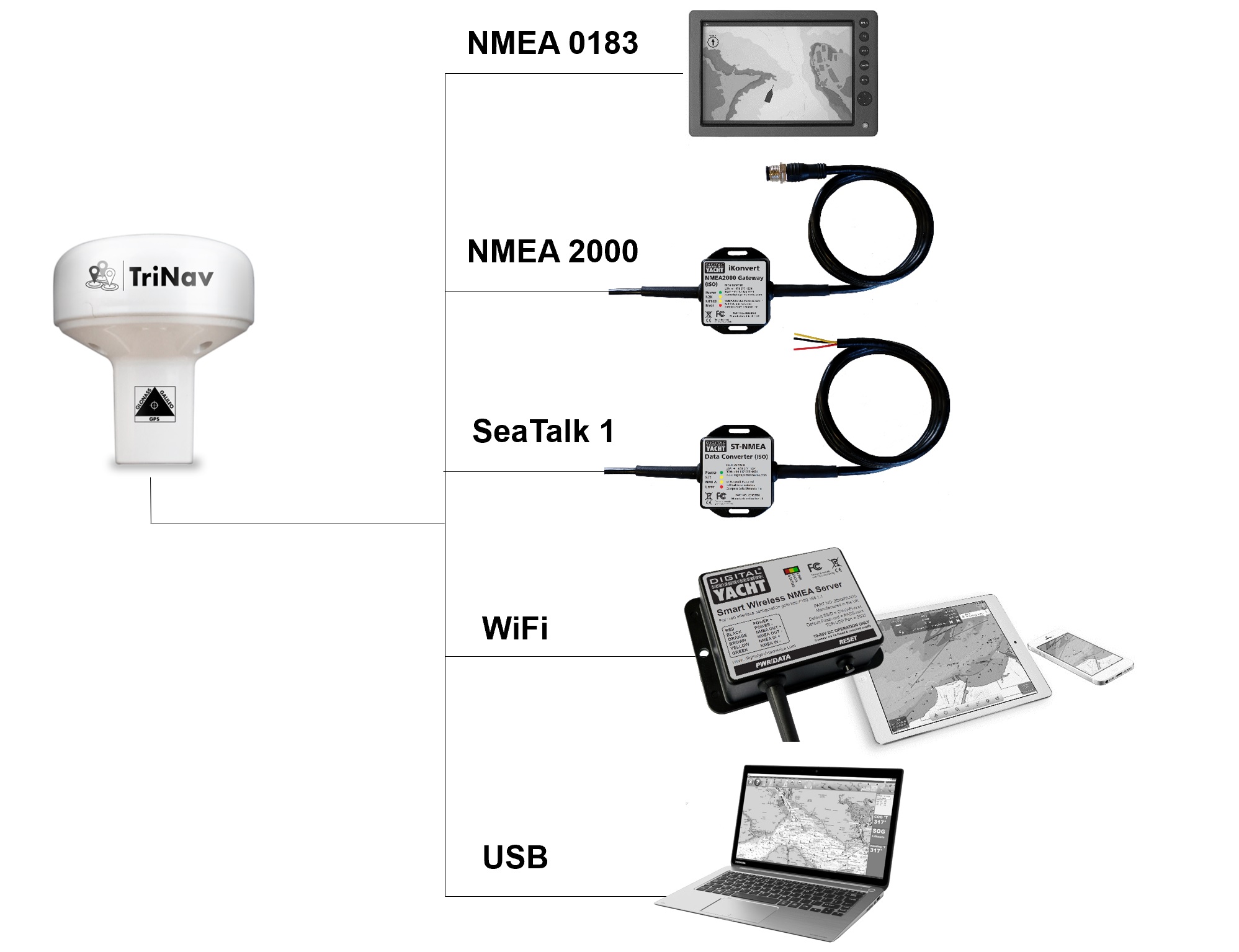(the price includes VAT)
Digital Yacht have unveiled their TriNav™ GPS160, a GPS antenna with NMEA 0183. This is a new, high performance positioning sensor using GPS, Glonass, and the new Galileo satellite systems. Therefore, providing exceptional position accuracy and redundancy. Typical accuracy is better than 1m. Data can also be set to output at up to 18Hz for smoother plotter track displays. TriNav™ software technology also improves positioning inaccuracy that could occur through spoofing and local interference.
KEY FEATURES
Digital Yacht have unveiled their TriNav™ GPS160, a GPS antenna with NMEA 0183. This is a new, high performance positioning sensor using GPS, Glonass, and the new Galileo satellite systems. Therefore, providing exceptional position accuracy and redundancy. Typical accuracy is better than 1m. Data can also be set to output at up to 18Hz for smoother plotter track displays. TriNav™ software technology also improves positioning inaccuracy that could occur through spoofing and local interference.
The device has a variety of modes through field programming. This includes single GNSS operation (eg Galileo only) as well as output configurations such as update rate, NMEA sentence structure etc.
The GPS160 with NMEA 0183 output (4800, 38400 and 115200 baud programmable). As well as a USB variant for PC, MAC and Linux. For NMEA 2000 systems, we offer a bundle with a Digital Yacht iKonvert NMEA 2000 gateway. Therefore allowing the easy and flexible install of NMEA 2000 without the need for cumbersome drop cables.
The GPS160 also supports a simple external MOB (man-over-board) switch or device. When triggered, the GPS160 creates a “synthesised” AIS SART MOB message on its NMEA output. This can then interface with a local plotter to identify the MOB. Most modern plotters support this with a clear MOB icon. As well as instant bearing and distance data to navigate to the casualty.

Galileo
Galileo is the new global navigation satellite system (GNSS) that has been in development over the past two decades. It joins the GPS and GLONASS systems and offers mariners a 3rd reliable positioning source. It is now fully operational as of 2020.
There are currently 22 satellites in usable condition. This means the satellite is working and adds to the service provision. There are then 2 satellites that are in “testing” and 2 more are marked as not available. The final constellation now consists of 30 satellites (24 operational and 6 spares) as of 2020.
October 2023 – New Features: All GPS160 models now feature a new GNSS engine that supports QuadNav technology. These models now support the Chinese Beidou satellites (as well as GPS, Glonas and Galileo), which means all position fixes, course and speed over ground calculations will now be utilising the strongest satellite signals from a network of over 100 satellites. This results in improved time to first fix, more robust operation against jamming, “spoofing” and outages and also improved current consumption (<25mA)
SPECIFICATIONS
72 channel GPS, Glonass , Beidou and Galileo GNSS positioning receiver
Typically sub 1m accuracy thanks to QuadNav™ technology –combines all satellite data for optimum accuracy
Can be configured as dedicated GPS, Glonass, Beidou or Galileo only device
Refined anti-spoofing algorithm for robust performance of position and interference rejection
Available Seatalk1 (with Seatalk converter), NMEA 2000 (with iKonvert interface) and wireless (with WLN10SM) variants
GPS160USB also available with USB connection for PC/MAC
User/field can select 4800, 38400 and 115200 baud operation through simple internal DIP switches
Many formats of NMEA data output including datum information –user can configure through internal DIP switches
Up to 18Hz update rate (user can select)
Ultra low (<20mA) power consumption at 12V DC
10m cable
Input for MOB switch/system –when triggered generates synthetic AIS MOB NMEA output to activate MOB position on plotter
Efficient system (ECDIS) support with datum sentence structure (DTM/GBS/GNS/GRS/GSA/GST)
Puck installation or fits 3rd party industry standard 1” x 14TPI threaded mount

Weight
514 g
Dimensions
245 × 165 × 100 mm